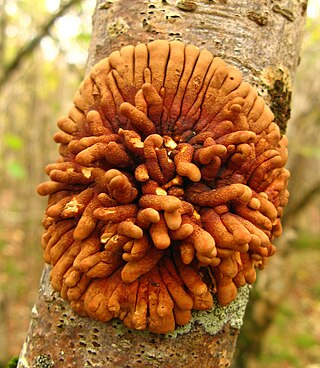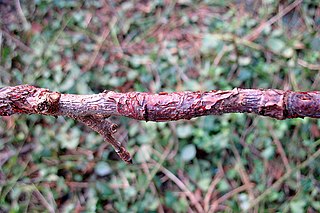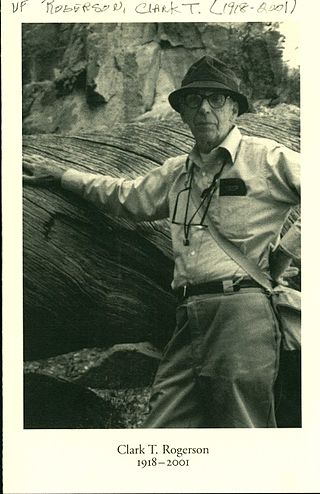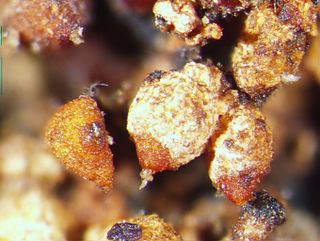
Sordariomycetes is a class of fungi in the subdivision Pezizomycotina (Ascomycota). It is the second-largest class of Ascomycota, with a worldwide distribution that mostly accommodates terrestrial based taxa, although several can also be found in aquatic habitats. Some are phytopathogens that can cause leaf, stem, and root diseases in a wide variety of hosts, while other genera can cause diseases in arthropods and mammals.

Nectria is a genus of Ascomycete fungi. They are most often encountered as saprophytes on decaying wood but some species can also occur as parasites of trees, especially fruit trees and a number of other hardwood trees. Some species are significant pests causing diseases such as apple canker, Nectria twig blight, and coral spot in orchards.

The Nectriaceae comprise a family of fungi in the order Hypocreales. It was circumscribed by brothers Charles and Louis René Tulasne in 1865. In 2020, an Outline of fungi was produced and listed 70 genera and about 1,336 species.

Fusarium solani is a species complex of at least 26 closely related filamentous fungi in the division Ascomycota, family Nectriaceae. It is the anamorph of Nectria haematococca. It is a common soil fungus and colonist of plant materials. Fusarium solani is implicated in plant disease as well as human disease notably infection of the cornea of the eye.

Geoglossaceae is a family of fungi in the order Geoglossales, class Geoglossomycetes. These fungi are broadly known as earth tongues. The ascocarps of most species in the family Geoglossaceae are terrestrial and are generally small, dark in color, and club-shaped with a height of 2–8 cm. The ascospores are typically light-brown to dark-brown and are often multiseptate. Other species of fungi have been known to parasitize ascocarps. The use of a compound microscope is needed for accurate identification.

The Bionectriaceae are a family of fungi in the order Hypocreales. A 2008 estimate places 35 genera and 281 species in the family. Species in the family tend to grow on plant material, including woody debris, while some species associate with algae, bryophytes, or other fungi.

Lasionectria is a genus of fungi in the class Sordariomycetes. It consisted of six species in 2008, and 16 in 2023.
Protocreopsis is a genus of fungi in the class Sordariomycetes. It consisted of nine species in 2008, and up to 11 species in 2023.

Hypocrea is a genus of fungi in the family Hypocreaceae. The widespread genus is estimated to contain 171 species that grow on rotten wood, and are often associated with other fungi. Anamorphic genera associated with Hypocrea include Acremonium, Gliocladium, Trichoderma, and Verticillium. Hypocrea was circumscribed by mycologist Elias Fries in 1825. Due to changes within the code of nomenclature, the genus Trichoderma has been proposed for conservation over its teleomorph Hypocrea. This means that all species with both a Hypocrea and Trichoderma name will be officially known by their Trichoderma name, and any species only described as Hypocrea will be transferred to Trichoderma.

Hypocreopsis is a genus of ascomycete fungi that form stromata on the stems of trees and shrubs. The stromata are orange-brown and consist of radiating, perithecial lobes.
Albonectria is a genus of ascomycete fungi in the family Nectriaceae.

Cosmospora is a genus of ascomycete fungi in the family Nectriaceae. The genus, as circumscribed by Rossman et al. (1998), included all the nectrioid species with small, reddish, non-ornamented sexual fruiting bodies that collapse laterally when dry. However, the genus was shown to be polyphyletic, and the majority of species were re-classified into revived or recently established genera that are monophyletic. Cosmosporasensu Rossman housed members of the following genera: Chaetopsina, Cylindrocladiella, Fusicolla, Macroconia, Mariannaea, Microcera, Pseudocosmospora, Stylonectria, and Volutella. Cosmospora was restricted to species having acremonium-like asexual morphs that grow on polypores and xylariaceous fungi by Gräfenhan in 2011. About 20 species are accepted in the genus.
Neocosmospora is a genus of fungi in the family Nectriaceae.

Neonectria is a genus of fungi in the family Nectriaceae.

Helicobasidium is a genus of fungi in the subdivision Pucciniomycotina. Basidiocarps are corticioid (patch-forming) and are typically violet to purple. Microscopically they have auricularioid basidia. Asexual anamorphs, formerly referred to the genus Thanatophytum, produce sclerotia. Conidia-bearing anamorphs are parasitic on rust fungi and are currently still referred to the genus Tuberculina.

Clark Thomas Rogerson,, was an American mycologist. He was known for his work in the Hypocreales (Ascomycota), particularly Hypomyces, a genus of fungi that parasitize other fungi. After receiving his doctorate from Cornell University in 1950, he went on to join the faculty of Kansas State University. In 1958, he became a curator at The New York Botanical Garden, and served as editor for various academic journals published by the Garden. Rogerson was involved with the Mycological Society of America, serving in various positions, including president in 1969. He was managing editor (1958–89) and editor-in-chief (1960–65) of the scientific journal Mycologia.
Wenying Zhuang is a Chinese mycologist. She is known for her contributions to the study of species diversity and phylogeny of Ascomycetes.

Corallonectria is a genus of ascomycete fungi in the family Nectriaceae. Species of Corallonectria are Neotropical. These fungi are characterized by the formation of brightly colored rhizomorphs and of copulated synnematous fusarium-like asexual morphs in culture. The asexual morph in nature has been rarely observed. The sexual fruiting bodies are furfuraceous and usually seated at the base of a reddish synnemata. It is a monotypic genus containing the sole species Corallonectria jatrophae. This species was formerly classified under Corallomycetella.

Corallomycetella elegans is one of the two recognized species in the fungus genus Corallomycetella. It is a parasite of rubber, cacao and tea trees.
Amy Yarnell Rossman is an American mycologist and a leading expert in identifying fungi.















